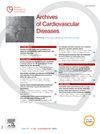Assessing cardiovascular changes in pregnant women with diabetes: Insights from echocardiography
IF 2.2
3区 医学
Q2 CARDIAC & CARDIOVASCULAR SYSTEMS
引用次数: 0
Abstract
Introduction
Pregnancy induces cardiovascular changes to support maternal and fetal needs. In diabetic women, these adaptations may be disrupted, leading to complications. Echocardiography helps to detect abnormalities in maternal heart function.
Objective
This study aimed to compare echocardiographic parameters between diabetic and non-diabetic pregnant women.
Method
This cross-sectional study included 36 diabetic pregnant women (Group 1) and 36 non-diabetic pregnant women (Group 2). Exclusion criteria included pregnancy complications, comorbidities, preexisting cardiac conditions, and infections. Participants underwent clinical evaluations, physical exams, and echocardiographic assessments.
Results
Both groups had comparable mean ages (30 ± 6 years for Group 1 vs. 30 ± 4 years for Group 2, P = 0.8). Mean arterial pressure was similar (80 mmHg for Group 1 vs. 70 mmHg for Group 2, p = 0.57). No significant difference in heart rate (P = 0.11) or RVFS (P = 0.11). Cardiac output was also comparable (6.28 mL/m2 for Group 1 vs. 6.0 mL/m2 for Group 2, P = 0.66). Significant differences in BMI (29 ± 5 kg/m2 for Group 1 vs. 33 ± 7 kg/m2 for Group 2, P = 0.03) and BSA (1.9 m2 vs. 2.0 m2, P = 0.03) were observed. Group 1 had lower LVEF (61%) compared to Group 2 (65%) (P < 0.01). Ejection systolic volume and inferior vena cava measurements also differed (P < 0.01 and P = 0.03, respectively).
Conclusion
Diabetic pregnant women had higher BMI, BSA, and slightly lower LVEF compared to controls. However, other cardiovascular parameters, including cardiac output, were similar between groups. These findings highlight the need for tailored management and careful monitoring to manage diabetes’ impact on pregnancy.
评估糖尿病孕妇的心血管变化:超声心动图的见解
妊娠引起心血管变化以支持母体和胎儿的需要。在糖尿病女性中,这些适应可能会被破坏,导致并发症。超声心动图有助于发现产妇心功能异常。目的比较糖尿病与非糖尿病孕妇超声心动图参数。方法本研究选取36例糖尿病孕妇(第一组)和36例非糖尿病孕妇(第二组)。排除标准包括妊娠并发症、合并症、既往心脏疾病和感染。参与者接受了临床评估、体格检查和超声心动图评估。结果两组患者的平均年龄相当(组1为30±6岁,组2为30±4岁,P = 0.8)。平均动脉压相似(组1为80 mmHg,组2为70 mmHg, p = 0.57)。心率(P = 0.11)和RVFS (P = 0.11)无显著差异。心输出量也具有可比性(组1为6.28 mL/m2,组2为6.0 mL/m2, P = 0.66)。BMI(组1为29±5 kg/m2,组2为33±7 kg/m2, P = 0.03)和BSA(组1为1.9 m2,组2为2.0 m2, P = 0.03)差异有统计学意义。1组患者LVEF(61%)低于2组(65%)(P <;0.01)。射血收缩容积和下腔静脉测量也有差异(P <;P = 0.03)。结论糖尿病孕妇BMI、BSA均高于对照组,LVEF略低于对照组。然而,其他心血管参数,包括心输出量,在两组之间是相似的。这些发现强调了有必要进行量身定制的管理和仔细监测,以管理糖尿病对妊娠的影响。
本文章由计算机程序翻译,如有差异,请以英文原文为准。
求助全文
约1分钟内获得全文
求助全文
来源期刊

Archives of Cardiovascular Diseases
医学-心血管系统
CiteScore
4.40
自引率
6.70%
发文量
87
审稿时长
34 days
期刊介绍:
The Journal publishes original peer-reviewed clinical and research articles, epidemiological studies, new methodological clinical approaches, review articles and editorials. Topics covered include coronary artery and valve diseases, interventional and pediatric cardiology, cardiovascular surgery, cardiomyopathy and heart failure, arrhythmias and stimulation, cardiovascular imaging, vascular medicine and hypertension, epidemiology and risk factors, and large multicenter studies. Archives of Cardiovascular Diseases also publishes abstracts of papers presented at the annual sessions of the Journées Européennes de la Société Française de Cardiologie and the guidelines edited by the French Society of Cardiology.
 求助内容:
求助内容: 应助结果提醒方式:
应助结果提醒方式:


